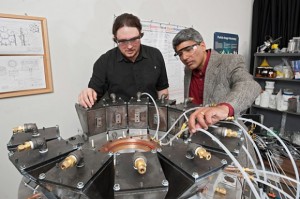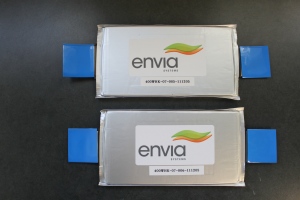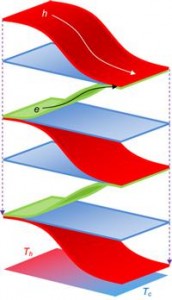 Here’s a cool gadget that’s a bit counter to the ‘keep it simple’ philosophy. It’s a thermoelectric device buried under a pot, designed for backpacking use to charge your iPhone and other gadgets (you’re not really keeping it simple if you’re depending on those while backpacking!). So if you really can’t leave those gadgets behind when backpacking, this is the perfect solution to ensure they’re always fully charged. The alternative would be solar panels, though if you assume that you’ll be making a campfire regardless, then this might be more reliable than counting on sunshine. The inventors are currently seeking funding at Kickstarter; cost is $125.
Here’s a cool gadget that’s a bit counter to the ‘keep it simple’ philosophy. It’s a thermoelectric device buried under a pot, designed for backpacking use to charge your iPhone and other gadgets (you’re not really keeping it simple if you’re depending on those while backpacking!). So if you really can’t leave those gadgets behind when backpacking, this is the perfect solution to ensure they’re always fully charged. The alternative would be solar panels, though if you assume that you’ll be making a campfire regardless, then this might be more reliable than counting on sunshine. The inventors are currently seeking funding at Kickstarter; cost is $125.
Self-sustaining solar-powered Hydrogen generator
 Engineers at the University of Delaware have developed a prototype hydrogen generator that has the potential to revolutionize solar energy production. Solar thermal energy is used to vaporize zinc oxide powder. This gas is then reacted with water to produce hydrogen gas and zinc powder (which can then be fed back into the system). The shortcoming of any solar energy system is energy storage, and a system that produces hydrogen gas solves that as the gas can be stored for later conversion to electrical power in a fuel cell.
Engineers at the University of Delaware have developed a prototype hydrogen generator that has the potential to revolutionize solar energy production. Solar thermal energy is used to vaporize zinc oxide powder. This gas is then reacted with water to produce hydrogen gas and zinc powder (which can then be fed back into the system). The shortcoming of any solar energy system is energy storage, and a system that produces hydrogen gas solves that as the gas can be stored for later conversion to electrical power in a fuel cell.
The system requires further testing but it’s off to a promising start! Read more at Physorg.
Electricity From Ambient Heat
While there are many methods of converting heat energy into electrical energy, they’re typically inefficient (thermoelectric) or need to be done at a larger scale (steam turbines). Researchers at the Hong Kong Polytechnic University are showing promising results with a different approach. You see, the atoms in a liquid are in constant motion. They found that when copper ions collided with a strip of graphene immersed in a solution, the collision dislocated an electron out of the graphene, and it then traveled through the graphene strip, essentially replicating the function of a battery and illuminating an LED as a result.
As with any science, further tests are needed to verify the reaction and rule out secondary effects being responsible (such as chemical reactions). If validated, though, this has enormous potential, for it would enable the generation of electrical energy from any heat source (something planet has no shortage of). It’ll be interesting to see if this pans out.
Read more here.
Envia Systems Battery – 400Wh/kg
 Electric cars are great, but battery technology continues to be holding them back from mainstream acceptance, the limiting factors being battery capacity and cost. Many companies are working on this problem, and Envia Systems recently announced they’ve achieved an energy density of 400Wh/kg, roughly 2-3X the energy capacity per unit of weight as current batteries on that market and at a lower cost. You can expect to see this on the market around 2015, with the result being 300-mile range electric cars for maybe as little as $20k. Read more over at gigaom.
Electric cars are great, but battery technology continues to be holding them back from mainstream acceptance, the limiting factors being battery capacity and cost. Many companies are working on this problem, and Envia Systems recently announced they’ve achieved an energy density of 400Wh/kg, roughly 2-3X the energy capacity per unit of weight as current batteries on that market and at a lower cost. You can expect to see this on the market around 2015, with the result being 300-mile range electric cars for maybe as little as $20k. Read more over at gigaom.
Flexible Thermoelectric Fabric
 Thermoelectric devices have been around for a long time, and offer the awesome ability of converting a heat difference (one side of the device cold, the other hot) into electrical energy – or reversing the process and using electricity to create that thermal difference (great for car-powered refrigerators, for example). Now, researchers at Wake Forest University have taken this basic technology and transformed it into a multi-layer, flexible felt-like fabric. Possible applications could include wearable electronics (though the ambient air temperature needs to be significantly lower than body temperature), or simple things like wrapping pipes in this.
Thermoelectric devices have been around for a long time, and offer the awesome ability of converting a heat difference (one side of the device cold, the other hot) into electrical energy – or reversing the process and using electricity to create that thermal difference (great for car-powered refrigerators, for example). Now, researchers at Wake Forest University have taken this basic technology and transformed it into a multi-layer, flexible felt-like fabric. Possible applications could include wearable electronics (though the ambient air temperature needs to be significantly lower than body temperature), or simple things like wrapping pipes in this.
Portable electronics have always struggled with their power sources, with design having been a tradeoff between storage capacity and size/weight/cost. Being able to generate energy on the move would be a big benefit.
Read more on this over at Design News.



